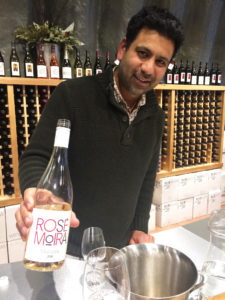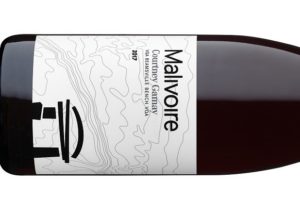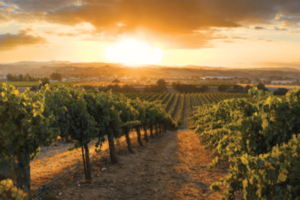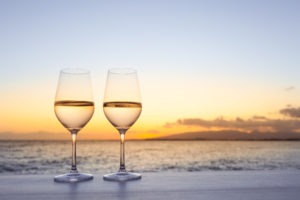
When winemakers talk about having the right piece of land, they’re generally referring to where their vineyards are planted. But for Malivoire Wine Company, it goes a little deeper—or should we say higher?
Built into the slope of a ravine—something that’s dramatically visible the moment you step into the tasting room thanks to a glass wall revealing the gravity flow production facility behind it—Malivoire takes advantage of the natural lay of the land to assure as gentle a treatment as possible of its wine as it makes its way the from the crushing stage to pressing to the barrel. The minimum-intervention approach helps to prevent the finished product from being oxidized or too tannic, while preserving the purity of the fruit.
The main man overseeing that process is Shiraz Mottiar, head winemaker at Malivoire Winery and the 2017 Ontario Wine Awards Winemaker of the Year. Born in Fergus, Ontario, Mottiar attended Brock University’s Climate Oenology and Viticulture Institute when it first opened and was a member of the first graduating class in 2000. He joined Malivoire as a cellar hand shortly thereafter, before a brief stint in Australia’s Yarra Valley with Coldstream Hills Winery. He then returned to Malivoire, eventually assuming the lead winemaking role in 2005.
The Lush Life: I see your rosé labels have been updated.
Shiraz Mottiar: “There’s been a slight change, adding the contour lines of the landscape in the background. And we actually changed the colour of the letters a bit for 2018, because rosé has an interesting spectrum of colour—you can go as light as onion skin, then cantaloupe, peach, watermelon, and into reds. Having the right colours to work with the wine is important. I’d rather adjust the colours on the label than the colour of the wine!”
Your 2018 Moira Rosé is outstanding.
“I love the fruit. It’s not jammy; it’s a pure ripe strawberry with hints of cherry. But there’s a savouriness and saltiness to the wine that I really like. A little herbaceous.”
There’s a beautiful delicacy and texture to it.
“It’s interesting. We travelled to Provence a few years back and the one thing we discovered was that every producer had a dairy tank in the cellar. We asked, ‘What’s the purpose of the dairy tank?’ They said they take the juice straight from the press to the dairy tank to chill it. I asked, ‘Why wouldn’t you just use regular chilling coils?’ They said that pumping it through like that is a bit aggressive, whereas these tanks are designed to quickly chill milk down from 36C to 4C. And they also have a paddle. So in combination with the ability to chill quickly but gently, you can stir the lees and add a little more flesh to the juice. It seems to add more complexity to the wine. And every single place we went to had one of these. So I thought, ‘This is something we need to do.’ So we got one in 2016.’”
Are you aware of other Ontario wineries using dairy tanks?
“Norman Hardie has a lot of dairy tanks, but he uses them for Chardonnay and for fermentation. But I don’t know of anyone else who has one purely for chilling juice. I think it’s a key element to taking it up a step, while also preserving the freshness of the juice.”
Let’s talk Chardonnay. Your 2017 is serious value for just $19.95—I picked up melon, pineapple, pear, Granny Smith apple—and a really nice balance of medium weight and acidity.
“2017 was a good year for Chardonnay—cool and crisp. I like the acidity. This one was actually fermented in stainless steel, and then aged a few months in barrels before being blended. (And you have to be competitive) price-wise. There are a lot of great Chardonnays out there. You can still get a decent Chablis in the mid-$20s, and California still dominates the Chardonnay segment.”
Unfortunately, California and many consumers still love their heavy, oaky, vanilla styles.
“I had that challenging discussion with some of our sales reps, especially the ones that help with the LCBO. This wine doesn’t go through the LCBO—we make our other chardonnay for them. I’m always trying to dial back the oak. But they say, ‘If you lose all the oak, some people won’t recognize it as Chardonnay.’ This one has about as little oak as I’ve put in a Chardonnay in a long time without calling it an unoaked Chardonnay.”
Speaking of your Chardonnay, I’m a fan of your $35 Bisous Brut (82% chardonnay, 18% pinot noir).
“It took a while to finally make that leap into sparkling, but I’m really glad we did. I think there’s a huge future—HUGE future for sparkling around here.”
How many acres under vine for you folks?
In total we farm about 80 acres, so 30 hectares (over four farms). “We don’t farm the Stouck farm, but that’s an integral vineyard that we get fruit from.”
A highlight for this summer?
“Our Viognier ($24.95) is just released. We bottled the 2018 in April. It has become really popular. It’s a difficult variety to grow, though. It’s strange in its texture as a grape. Gets a little flaccid—you think it’s not working in the soils. But once you make the wine, it turns out great. It’s aromatic, and there’s a nice elegance to it. There’s a mix of citrus and exotic fruit, which is very appealing.”
Give me a few of your Ontario favourites?
“I really like Meldville—Derek Barnett’s project. His Sauvignon Blancs are the best. Although Five Rows also makes a great one—they just make great wine.
“Adamo up at Hockley Valley is making some interesting wines—their Rieslings and Chardonnays. They’re up in Mono, but a lot of their fruit is from around here. In the County, I really Rosehall Run and Trail Estate. I’ve always been impressed by Exultet Chardonnays. And we’re next door to Cave Springs, and nobody makes a better Riesling. And their quality of Cab Franc is pretty outstanding too.”
How do you respond to people who say Ontario wine is too expensive compared to wines from other parts of the world? Most don’t appreciate the cost of making wine here.
“I wouldn’t compare our wines to those less than $15 from, say, the southern hemisphere. Rather, I see our wines at $20 offering great value compared with wines north of $25 from the Old World. I was recently in Muscadet, and our land prices here in Ontario are at least five to 10 times more expensive than there. And I was at an established vineyard! Even in Beaujolais, for smaller Crus like Morgon or Moulin-a-Vent, I think the land prices there are the same or even less than here. We have a very small area to grow grapes. And for the more successful areas, like along the lakeshore and on the Bench, the prices are going to be pretty high. At least we’re not crazy expensive like the Okanagan. Here we’re still finding new pieces of land and starting up.
“But an established vineyard here is $50,000 to $75,000 an acre. How long does that take to pay off!? As far as the vines go—we’re under the constant threat of winter. We need to replant. When you’re in France and you see these 100-year-old Cabernet or Gamay vineyards…how am I ever going to do that in Ontario? Well, certainly I won’t. But it would be great if one day we can say that. Currently, it’s around the 30-year mark when we have to replant a vineyard. So you only have 30 years before you have to reinvest all that again.
“And plant material is certainly getting more expensive every year, especially with some of the viruses that are popping up. It’s costlier to get clean material. And labour is expensive—were up to $14 an hour. And the cost of living is higher here than in some other countries. And that imparts costs.”
Workers compensation, health insurance—there are some expenses that wineries in countries like Chile or South Africa probably don’t incur.
“I can’t remember what the number is—it probably adds another 15-20% to the value of an hour’s work.”
Economies of scale don’t help.
“We’re in an environment where there is lots of management to be done in the vineyard, because it grows so fast. One person cannot slowly manage this vineyard over the whole season. You need an influx of many people to get the job done quickly, because the vines are growing so fast. Our growing season only starts in mid-May, whereas as others start in mid-February, so it’s a much slower growing process. Those things add a lot to the costs. But it’s the cost of everything—the cost of fuel to run equipment…”
And there’s the price of fruit you don’t grow.
“There are three pricing scales for Ontario fruit. The bottom tier is the plateau pricing scale. That’s where a producer and processor/winery will agree to crop it between whatever tonnage up to a certain maximum. And they’ll give you $1,200 or $1,350 a tonne. That’s the cheapest you can buy a vinifera variety in Ontario. That doesn’t drive up the quality—that’s really filling up the shelves at the lower end. And even then, about $13 a bottle is the cheapest you can get for a VQA vinifera. The next level is the GGO Pricing Scale, which is based on sugars, so as sugars rise, the cost per tonne goes up. If you’re looking at Chardonnay, you might start around $1,500 and go up to $1,800 a tonne. And then, lastly, you have your premiums, which is outside of the Grape Growing Marketers Board—it’s something that just happens between wineries and growers, and it could be anywhere from another $100 to $500 a ton beyond that, and sometimes even more.”
What’s the highest you’ve heard of?
“Then there’s the fruit in the County, which I hear is even more expensive, because there’s a lot more work they have to do. I’ve never bought any of it—there aren’t many from Niagara who do—but I hear that’s the most expensive fruit. But here, maybe double the GGO price. So if there was a Chardonnay that was $1,600 a ton, the highest someone might ask is $3,200.”
So the margins aren’t big.
“We make enough money to keep everyone employed. To keep the lights on. Hopefully save enough to invest in something new when it needs to be replaced, because everything has a lifespan. A tractor has maybe 15 years in it. A trellis has 20-25 years in it. Even your furnace has about 10 years. So there’s always something.
“But there are a few wineries in Ontario where I do wonder, ‘How do they sell VQA wines for that cheap?’ Even if someone were to sell wine for $40, I get that! I kind of have a sense of where that $40 is going. And there are many like that. Some of Leaning Post’s are $40-$50. Stratus is always up there. And there are some that go higher. Thirty Bench Cab Franc gets $70. Stratus had a Cab Franc for close to $100. Those are expensive wines. But it’s also a statement: ‘If you’re going to pay $100 for a bottle of wine from France, why not pay that for an Ontario wine that is of equal value?’ The quality and workmanship are there. The way the grapes are farmed is there.”
Plus, you’re getting the experience and the education for free when you visit a winery.
“It’s a great experience, and we don’t charge for that. Just the tasting fee.”




1 Comment
Leave your reply.